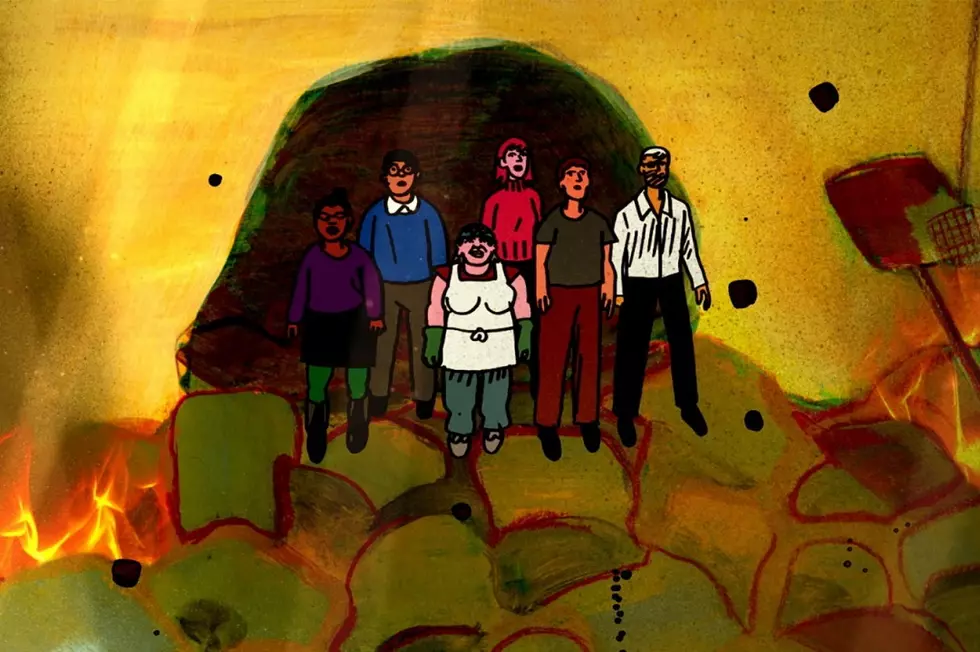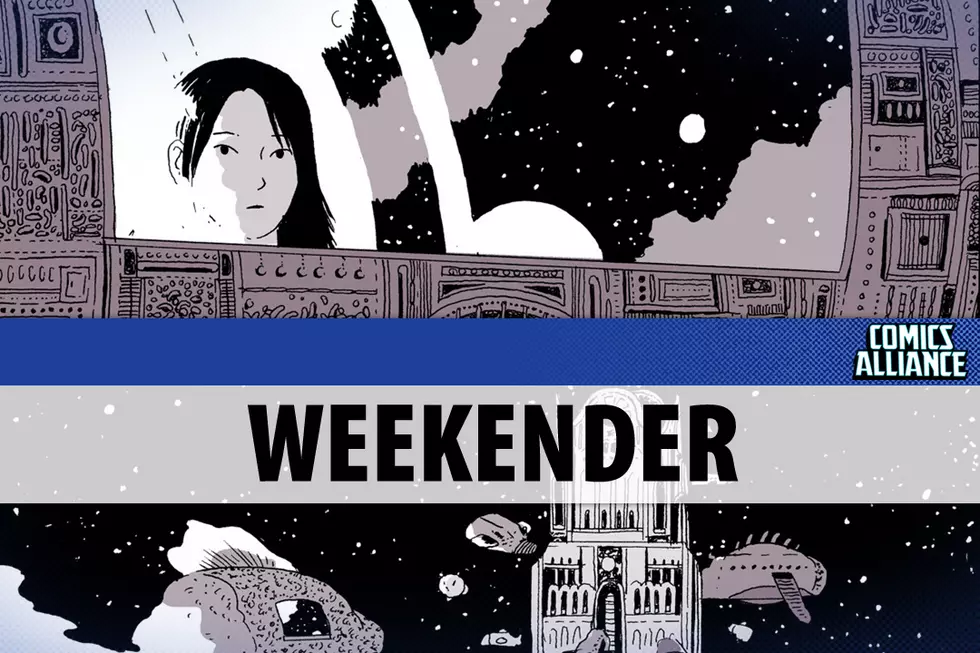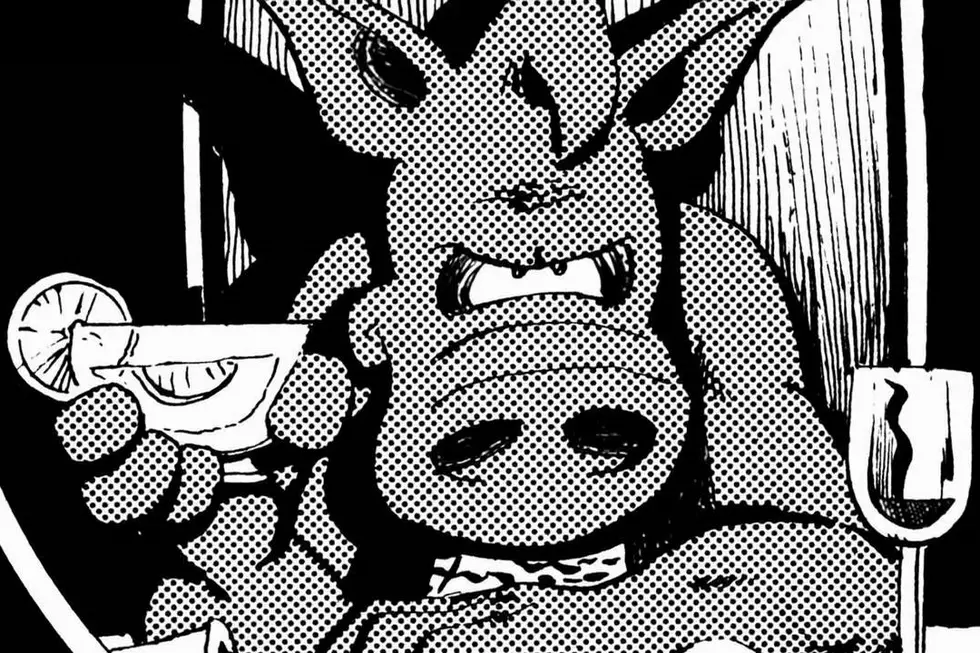![Dash Shaw’s ‘New School’ Delivers Bewildering Color & Complex Emotions [Review]](http://townsquare.media/site/622/files/2013/07/It-is-good.jpg?w=980&q=75)
Dash Shaw’s ‘New School’ Delivers Bewildering Color & Complex Emotions [Review]
Since his quirky, moving, and massive Bottomless Belly Button made every person in the world's best books of 2008 list, cartoonist Dash Shaw has turned his attention to shorter forms and new media. The long-running webcomic Bodyworld, the short story collection The Unclothed Man in the 35th Century AD, and the IFC animated shorts of the same name have all been marked successes, but many readers, myself included, wondered how long it would be before Shaw cycled back around to a new original graphic novel.
New School, the artist’s first long-form OGN in five years, is now available from Fantagraphics Books, and it answers our wonder with its own. A hardbound, 340-page story of brotherhood, prophecy, and theme parks, New School is surreal, emotional, and delirious with color.
Back before his polemic overshadowed his artistry, Dave Sim held an infamous lecture for young artists at the Savannah College of Art & Design wherein he spoke about the necessity of work ethic and the importance of style. He wrote about the experience in the essay “Misunderstanding Comics” in Cerebus #194, from May 1995, and in reading New School, I couldn’t help but be reminded of it and forced to dig it out:
“…I mentioned that you could stand ten feet away from five pages of Spawn, five pages of Cerebus and five pages of From Hell, and you’d have a pretty good idea of whose work you were looking at. A creator’s style doesn’t exist exclusively in stroke or pen line. There is also an overall ‘look’ that is idiosyncratic and which evolves in tandem with the penciling and inking techniques. I encouraged the students […] to take a larger view of what their pages will look like from a distance of ten feet and to work to make that ‘look’ distinctively their own.”
New School definitely has a look that is distinctively its own. Against the contoured chiaroscuro of his settings and characters – which look like they were done mostly with a Sharpie marker – Shaw blasts abstract explosions of color that make every page a new experience.
Employing oils, watercolors, acrylics, photographs, and airbrush – pretty much everything but “new school” digital coloring – Shaw lays down lines, plaid patterns, polka-dotted textures, and Mark Rothko-like landscapes that transform the pages into beautifully-juxtaposed collisions of black & white against color. It’s a dizzying, woozy, dream-like effect that alternately, sometimes simultaneously, conveys setting, tone, and the heightened emotional state of a teenage boy.
The protagonist of New School is Danny, a 16-year-old kid from New Jersey who loves drawing and worships his older brother Luke. After a fight that severely injures Danny, Luke leaves to teach English in a foreign nation simply known as “X” – an x-shaped island where they are building “Clockworld,” a theme park that recreates historical events like the JFK Assassination and the Great Fire of London. After Luke is absent and non-communicative for two years, Danny’s parents send him to X to retrieve his older brother and bring him home.
When Danny arrives at X, he finds Luke changed by his life there. Swept up in the adventure of living in a foreign land, and in love with a girl named Esther, another American English teacher, Luke has tasted the novelty of an uncommon life, and has no interest in going home.
As much as Danny wants his brother to return to his life, he also finds thrills and excitement in the surreal surroundings of X and Clockworld. But when Danny tries to embrace the same life, the foreignness of the Xians’ culture, his inability to be understood by anyone – both vocally and emotionally – and the apprehensions that come with young adulthood and independence send him into a spiral of selfishness and destructive behavior.
There’s definitely no religious message or vendetta to the story, but there are strong Biblical overtones throughout. Daniel and Luke, apart from having Biblical names, seem to be living out a fable that wouldn’t be out of place in the Old Testament. Two brothers fight, the older brother leaves for a distant land of wonder and temptation, and the parents send the younger brother on a quest to reunite the family.
There are also some interesting connotations with Danny's speech. While Luke and his girlfriend speak like young Americans, Danny’s voice is dramatic, bordering on self-exposition that comes across verse-like at times – especially when he proclaims “Possess me, Spirit!” or “It Is Good!” and Shaw renders the words in ornate Medieval script that bursts forth from the book, like in the double-page spread below.
The most overtly Biblical tone, though, is the matter of Danny’s premonitions. When Danny first arrives on X, the book erupts in colors. But for the first couple of chapters, while Luke and Danny are still living in New Jersey in the early nineties, color only appears in Danny’s dreams, which he believes can predict the future. At first, they only concern films that have yet to be made, like Jurassic Park and X-Men, but as the story goes on, the premonitions evolve, predicting later events that occur on X, Danny’s relationship with Luke, his life as an adult, and even 9/11.
It’s an interesting mix of art and story styles that fuel New School. The clash of the black & white art against the color; the intermingling of “high” art forms and “low” art forms; a story that blends family drama with homily, sci-fi, magical realism, and millennial anxieties while dealing with the failure of language, the importance of art, and the acceptance of one’s destiny as an adult.
Moving, innovative, and beautiful, it’s hard to imagine you’d confuse the woozy, dreamsick, and explosively colored pages of New School for any other artist’s, no matter what distance you’re viewing them from. Chalk this up as another win for Dash Shaw, and for us as well.
More From ComicsAlliance









